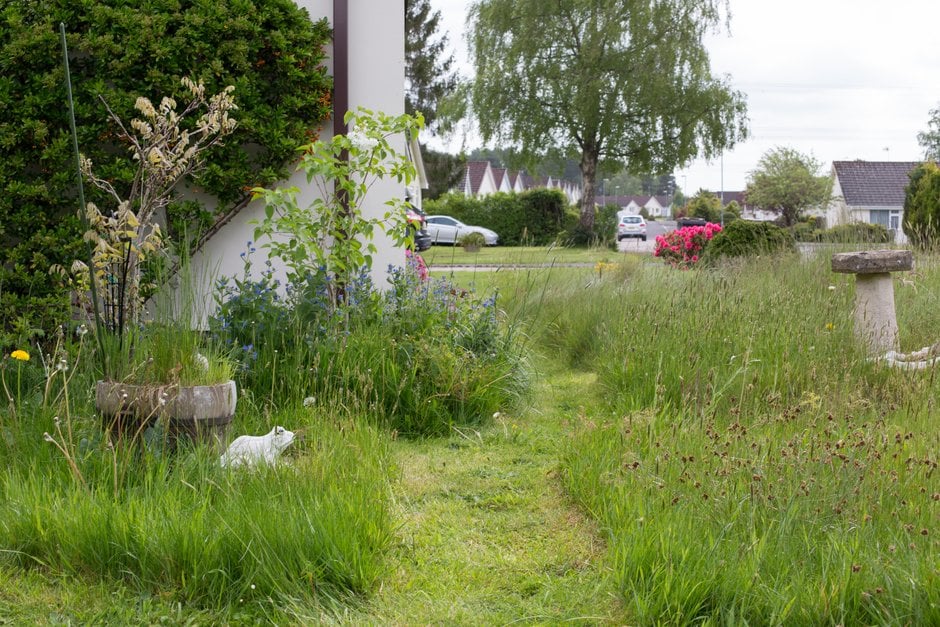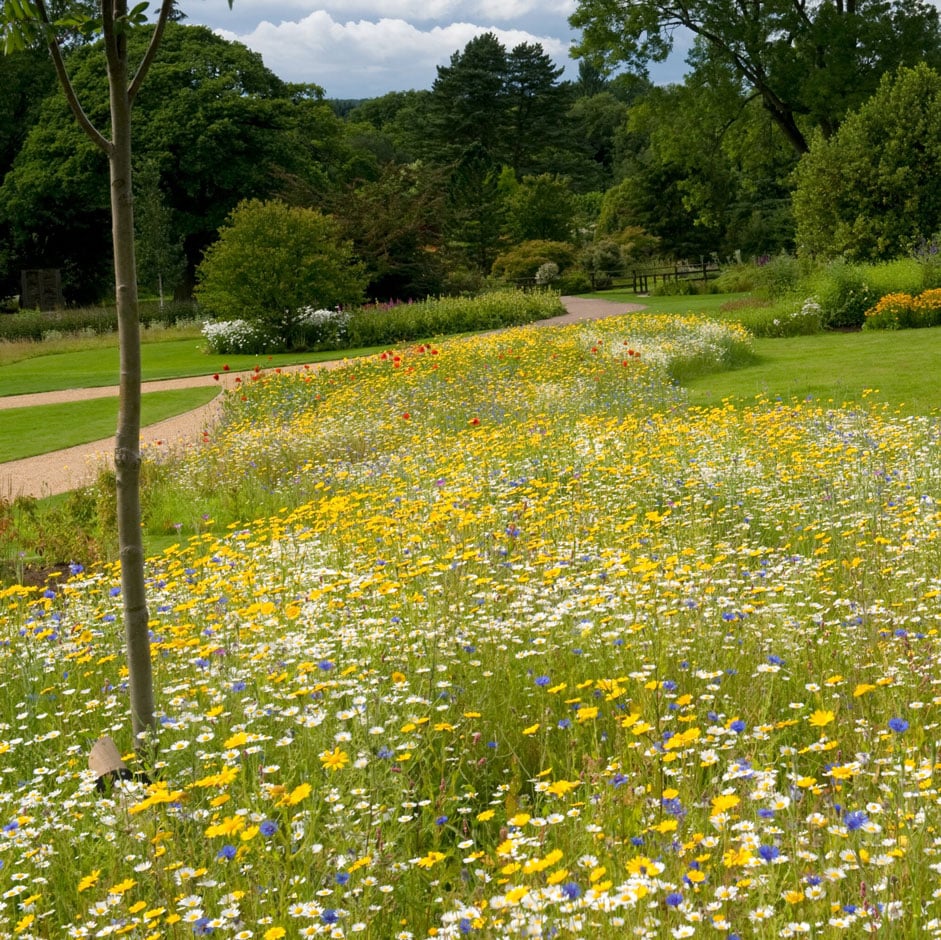Lawn care in autumn
Both traditional lawns and those that are more wildlife friendly will benefit from some extra care and attention in early autumn to get them into good shape for next year.

Quick facts
Skill level: Easy to moderate
Jump to
Why lawns and meadows need autumn care
By the end of summer, our lawns are often looking a little the worse for wear – hot, dry weather, or just increased use, can take their toll. But the mild, damp conditions of early autumn are ideal for carrying out some simple maintenance, and your grass should recover well before winter arrives.
Whether you love lush, neatly trimmed turf or have a more relaxed approach, allowing wildflowers to flourish, your lawn will benefit from some autumn maintenance. The key tasks below are best done in September or October, but they don’t all need to be done every year, so if you're short on time just pick one or two that are suitable for your lawn this autumn. You should see the benefits next year.
For full details see below, and also watch our quick video guide:

Autumn lawn care
Also see our monthly lawn advice for September and October.
Looking after
Autumn is also a good time to convert a lawn, or part of it, into a wildflower meadow, by sowing seeds and adding

Creating wildflower meadows

Lawn and mini-meadow habitats
If you already have a meadow area, autumn is the time to give it a final cut and consider whether it needs scarifying or aerating. See the following guides for tips:

Wildflower meadow maintenance

Lawn and mini-meadow habitats
How to scarify a lawn
This involves raking (or scarifying) the lawn to remove thatch (old grass clippings, moss and other debris) from the soil surface. Removing thatch helps the lawn to cope with drought, as water is better able to get down into the soil. Thatch can also reduce air circulation between the grass plants, which can lead to fungal problems. As a guide, if you can’t see the soil between the blades of grass, then your lawn would benefit from scarifying.
This is a simple process:
-
Rake your lawn vigorously with a spring-tined rake, aiming to reduce loose debris without uprooting the grass
-
Work first in one direction, then the other, so you remove as much thatch as possible
-
For larger lawns, consider hiring or buying a powered scarifier or scarifying mower attachment – or just rake a small section each autumn
-
Remove all the raked-out thatch and add it to your compost heap
-
Your lawn may look a bit patchy and rough afterwards, but don’t worry, it will soon recover and in the longer term will look and grow better as a result
See how it's done in our lawn care video (scarifying is the first job):

Autumn lawn care
Aerating and top dressing
Aerating (or spiking) a lawn improves the movement of air and water among the grass roots, helping the lawn to withstand periods of drought or waterlogging.
-
The simplest option is to spike the lawn with a garden fork – space each set of holes 10–15cm (4–6in) apart and go down as deep as you can, ideally to the full depth of the tines. Move the fork back and forth to enlarge the holes
-
This can be quite hard work, so if you have a large lawn, just concentrate on areas that receive the most wear or are compacted, or aerate a different area each autumn. You could also consider hiring or buying a powered aerator
-
For most lawns, aerating every two to three years should be adequate
-
On clay or waterlogged soil, it’s better to use a hollow-tined aerator, which makes wider holes that are even more effective at letting air and moisture into the lawn’s root zone and relieving compaction. The hollow tines extract plugs of soil – simply sweep these up, then rake a top-dressing (see below) into the holes to improve the soil structure. This is best done every three to four years
See how it’s done in our lawn-care video (aeration starts at 3:53 mins):

Autumn lawn care
Top dressing is the next step after aerating. It involves applying a mix of loam, sand and well-rotted organic matter to fill the aeration holes. It’s particularly useful on heavy soil, as it will improve the soil’s texture and drainage, which should encourage better rooting and denser grass.
You can buy ready-made top dressing or you can make your own by mixing:
-
three parts sandy loam (available from larger gardening retailers)
-
six parts sharp sand
-
one part peat-free multi-purpose compost
To measure the parts, use a large container such as a bucket – choose the size to match the amount of top dressing you want to make.
Apply the mix at a rate of 2–3kg per sq m (4–7lb per 10 sq ft) – which is about a shovelful each time. Work it into the aeration holes with the back of a rake or a broom. It should soon disappear. If there’s a lot left on the surface, apply less per square metre. If it all disappears very rapidly, apply a little more.
See how it's done in our video (top-dressing starts at 6:45 mins):

Autumn lawn care
Feed if hungry
Most lawns will recover well after summer’s wear and tear or drought without any feeding, and will be a rich green carpet again by the following year. But if your lawn is in need of a boost, you can apply an autumn lawn feed – just make sure it’s specifically formulated for autumn application. Autumn lawn feed encourages root growth through winter, rather than leafy growth.
But there’s no need to feed a lawn where you’re encouraging more wild plants to grow.
Be aware that artificial fertilisers take a lot of energy to manufacture and may have detrimental effects on the environment, so only apply if specifically needed and use the minimum amount to keep your grass in good shape – see our guide to using fertilisers and our guide to organic gardening.
When applying fertiliser, do it just before rain is forecast, at the rate specified on the packet – usually about a handful per sq m (sq yd). Scatter it as evenly as possible, or use a lawn-feed spreader with a trough, calibrated to the correct application rate. If it doesn’t rain within a day or so, water it in.
Also watch our lawn-care video (applying feed starts at 13:20 mins):

Autumn lawn care
Repairing any damage
Autumn is the ideal time to make repairs to your lawn. Hot, dry weather, fungal diseases, pets and pests can all cause damage, making your lawn look patchy and unkempt. So get your lawn back into good shape – find out how to re-seed or re-turf bare areas, even out any dips and bumps, and neaten up the lawn edges with our easy guide:

Repairing lawns
Problem solving
Several other issues are best tackled in autumn, including:
-
Moss – this often thrives in damp, poorly drained lawns. Many people enjoy the look and feel of it as an alternative to grass, and it’s beneficial for lawn biodiversity, but not everyone is a fan. If you want to reduce or get rid of moss, scarifying in autumn will help, and our guide to controlling moss has more tips on limiting moss in your lawn
-
If leatherjackets or chafer grubs are a problem in your lawn, you can apply a biological control as a preventative measure in early autumn
-
Fungal diseases can flourish in the warm damp days of autumn, although keeping your lawn in good shape can help to deter them. Still, keep an eye out for these common problems: red thread, fusarium patch and snow mould, take all patch, lawn rust and fairy rings
See also...
Lawn care in autumn video
Monthly lawn tips: September
Monthly lawn tips: October
Algae, lichens and liverworts on lawns
Lawn care in spring and summer
Lawns: weed control
Moss in lawns
Waterlogged lawns
Get involved
The Royal Horticultural Society is the UK’s leading gardening charity. We aim to enrich everyone’s life through plants, and make the UK a greener and more beautiful place.